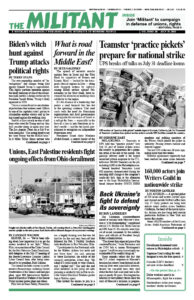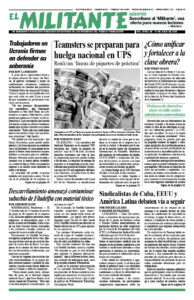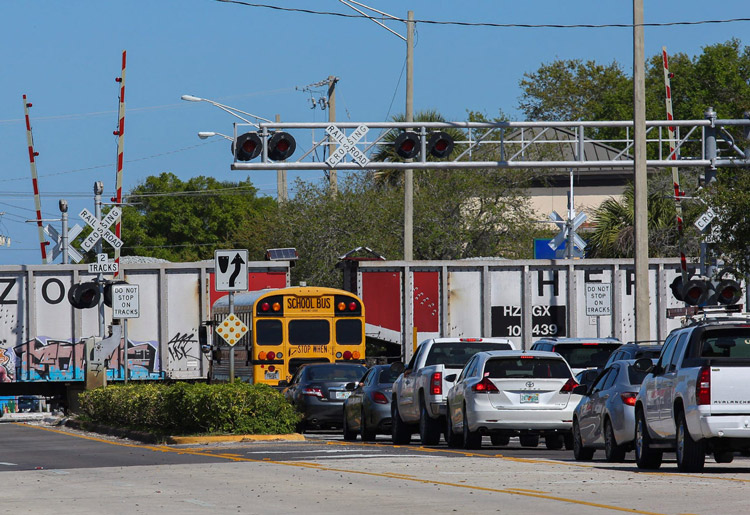BEAVER, Pa. — “We’ve been talking about how important it is to get the unions involved in our fight,” Hilary Flint, vice president of the Unity Council for the East Palestine Train Derailment, told delegates at the July 17 meeting of the Beaver/Lawrence Counties Central Labor Council here, after being introduced by its president, Rick Galiano.
The council includes unions in northwestern Pennsylvania, including United Steelworkers at the Tenaris mill and pipe plant, some 800 International Brotherhood of Electrical Workers at the Beaver Valley nuclear power plant and others.
Flint lives in Enon Valley, Pennsylvania, a largely farming area that was hit hard by the fire and toxic burn-off that followed the Feb. 3 Norfolk Southern train derailment in East Palestine, Ohio.
“I participated in the Pittsburgh rally for the Wabtec strikers last week and met Steve here,” she said, pointing to Steve Kocherzat, the editor of the council’s newsletter, Union Bug. “He asked if I could speak to your council, and I replied yes!” She said she and other members in her group are now planning a solidarity trip to Erie to visit the United Electrical Workers picket line at Wabtec again.
Flint invited the unions to join in a July 22 solidarity rally in nearby Lisbon, Ohio, demanding the federal government cover the area with special, free Medicare funding available to victims of environmental disasters .
Another upcoming protest is set in East Palestine Aug. 3 to mark the six-month anniversary of the derailment.
One council member asked whether they’ve gotten support from local politicians. “In the beginning, yes. Now, no support,” Flint said. “They tell us everything is OK on the Pennsylvania side. Believe me, it’s not.”
In the meeting and afterward, union members pledged to spread the word about the ongoing fight and encourage union participation in the protests. The council has up on its website a video that portrays how the “devastating aftermath of the train derailment in East Palestine is the most recent tragedy caused by corporations putting profits before people.”
Fight continues in East Palestine
Many area residents fear that Norfolk Southern bosses are just waiting for public attention to wane to move to drop any further responsibility for the disaster. But, as Flint indicated, local residents plan to continue making waves, and looking for allies, including from rail and other unions.
Norfolk Southern recently filed a lawsuit demanding that other companies — including those that built the cars that derailed and Oxy Vinyls and Dow Chemical that manufactured some of the toxic chemicals that got dumped on the soil, streams and into the air — share the cost of the cleanup. It also moved to have a class-action suit filed by people there seeking damages thrown out of court.
The company has poured money into public relations gestures, donating $25 million for renovation of the city park, lunch for 16 postal workers, donations for a community volunteer day and the like. “Some in town are echoing what the company and Environmental Protection Agency are saying, ‘Everything is fine now,’” Jami Wallace, president of the Unity Council, told the Militant. “But there are many needs unmet. People are still getting sick when they return to their homes. The Norfolk Southern Help Center is already telling some that the company won’t reimburse them for further expenses.
The Salem News reported July 18 that the EPA confirmed that both Sulphur and Leslie Run creeks continue to show signs of “gross” contamination. And contaminated soil near the tracks is still being dug up and hauled away.
Rail unions fight blocked crossings
Prominent articles in newspapers from the New York Times to the Fort Worth Report have highlighted the challenges facing working people from trains blocking road crossings across the country. In response to TV videos of children risking their lives climbing under and through stopped rail cars in Hammond, Indiana, Jared Cassity, assistant national legislative director for the SMART-TD conductors’ union, told the media that the problem has been made more dangerous by increasingly long trains that stretch for miles. SMART wants to see train length limited, he explained, but until that happens, the union wants train crews to be able to separate stopped trains that block crossings.
“It’s not a big deal, but because they want the train to move when they want the train to move,” he said, “they don’t want to lose the time of separating it and putting it back together.”
Kamron Saunders, SMART’s Texas state legislative director, told the Report that the blocked crossings also can occur when the crew has worked the legal limit of 12 hours but has not been relieved by the railroad. Or there wasn’t a big enough siding to put today’s lengthy trains out of harm’s way. He said the bosses insist on these longer trains. “It’s all about making money for the stockholders and that’s their only care.”
“Railroad employees do their very best to stay off the crossings,” Chris Bond, Local 513 SMART-TD local chair in Gainesville, Texas, told the Fort Worth paper. “But when the railroad refuses to listen to what we tell them about train lengths, and stuff like that, we can’t really do much about it.”
One-person train ‘crew’?
Union Pacific rail bosses announced July 17 they are launching a “pilot project” in August to prepare for running their freight trains with a one-person crew. This has long been their cost-cutting, profit-boosting dream.
The plan is to start assigning conductors to follow trains in trucks in Nebraska and Colorado, ready to respond if a problem comes up. For now there would still be a two-person crew on the train, but their goal is “to eliminate conductors on trains,” The Associated Press reported. They claim modern technology has made conductors superfluous.
Rail workers are all for technology, but they can’t replace human operation. Conductors help monitor track conditions and radio communications. In case of derailment, conductors are the first ones to respond before other help can arrive.
Conductors in trucks would never be able to operate in all kinds of weather and traffic conditions, and to follow trains whose tracks aren’t near modern roads.
“I would not feel safe with a 3-mile-long freight train carrying the most dangerous hazardous material on the planet through my community with only one set of eyes,” Greg Hynes, SMART’s national legislative director, told a Federal Railroad Administration hearing last December.
“The rail unions, as well as other unions need to look to using union power to exert workers control on the job,” Tony Lane, the Socialist Workers Party candidate for Allegheny County Executive in Pittsburgh and a former rail worker, told the Militant. “The unions should fight for trains no longer than 50 cars and for a crew of four with two on the rear of the train. Those two rear crew members can watch out for train malfunctions and assist in separating a train that’s blocking crossings.”


